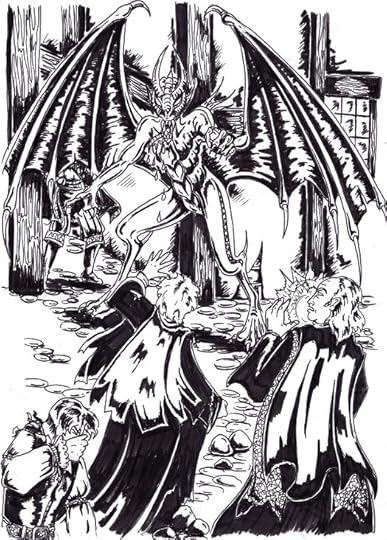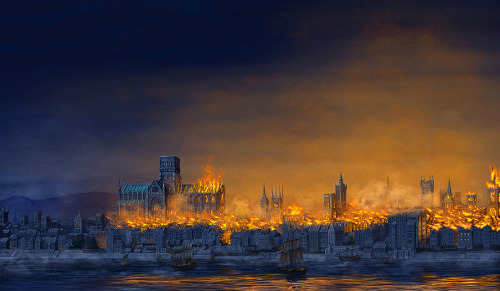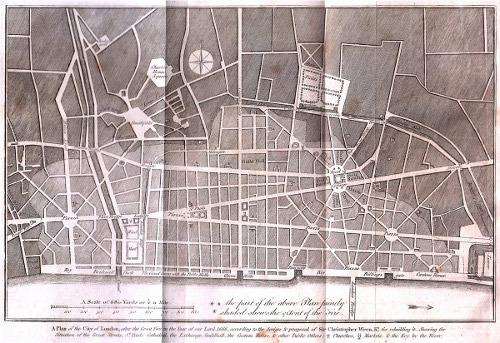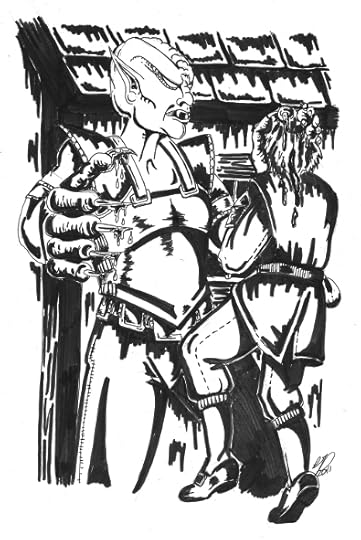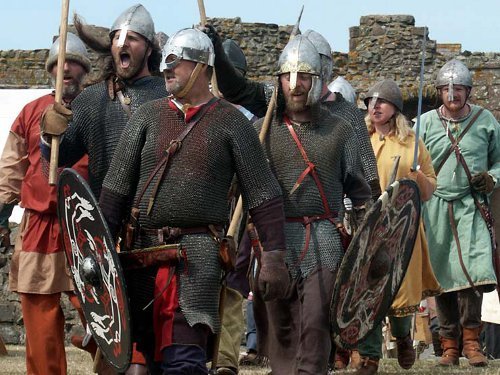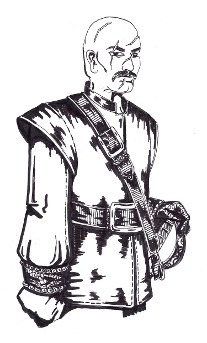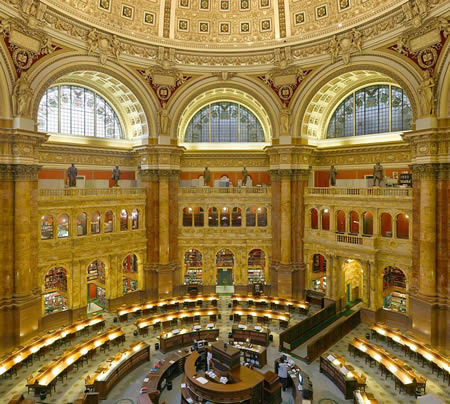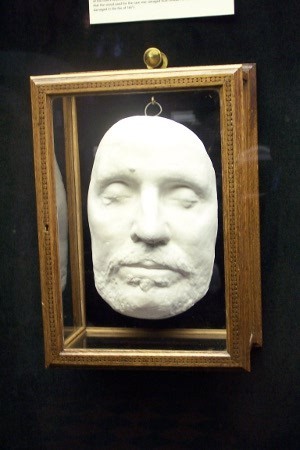Richard Denning's Blog, page 16
August 30, 2011
Birth of the demon's servant
As he saw the horror revealed, Ben stepped back and cried out in terror.
Scene from The Last Seal. Sketch is by Gill Pearce of Hellion's Art
"Both of you will stop right there and turn around slowly," ordered Gymer, "and you, Doctor, will drop that pistol to the ground and-"
He never completed the sentence. With a boom louder than thunder and a flash brighter than lightning, there was a sudden violent uprising of the street for fifty yards in all directions. Everyone in the immediate vicinity was knocked off his feet and stunned by the force of the detonation.
Ben could see nothing but blackness, nor hear a sound and for a moment he thought Gabriel had used his flash-bang attack again, though this time the smell was different: a pungent, acrid stench that caught in his throat and made him cough and retch at the same time. Finally, his vision began to clear and blinking he looked about him. To his side Tobias was pulling himself to his feet and clearing dust from his eyes. Gabriel was lying on his back and groaning. Gymer appeared to be knocked out and his three companions were staring blankly about them. Walton was the first to recover. He took a few steps towards the source of the explosion, his dark eyes wide and agitated. Still numb, Ben turned to follow his gaze.
The cracked and blackened cobbles of the street about ten yards from where Ben stood suddenly exploded upwards, sending chunks of stone high up into the air, from where they came spinning back to earth to smash into fragments on the street. One hit Walton on the shin and with a yelp of pain he collapsed again.
The eruption had thrown up a cloud of dust and released thick fumes from the cellars beneath the street. As a result, Ben could not see much for a few moments, but gradually the dust cloud settled and the smoke dispersed to join the black clouds given off by the fires around them. Through this smog, Ben perceived a dark shape standing in the lane. It was indistinct and hazy at first but, as visibility improved, its features came sharply into view. As he saw the horror revealed, Ben stepped back and cried out in terror.
Seven feet tall, the creature stood upright on two legs, but otherwise was utterly inhuman in appearance. Ben saw that its limbs, thorax and abdomen were covered in a hideous black-green external skeleton, much like an insect or spider. Behind it flapped bat-like wings, the skin stretched between thick ridges of bone that ended in long sharp spines. Its monstrous head bore needle-sharp teeth that were black, as was the tongue, which now flicked in and out. Its jaws were open and from them a brown liquid drooled and dripped on to the ground. Pale, pupil-less eyes gazed around the lane and fixed themselves upon Ben. From its mouth an ear-piercing screech emerged as it advanced upon him, claws snapping open as the beast prepared to attack.
Numb with shock and disbelief, Ben was rooted to the spot. As the creature took three steps towards him he knew he should run, but was incapable of movement. Then, from the alleyway behind Ben, Artemas barked out three words at the creature and it paused before giving another screech, which this time sounded like frustrated anger. Artemas spoke again and the creature tilted its head as if in acknowledgment. It threw Ben a hungry glare and then, with a single leap and beat of its wings, it passed over his head and landed at the entrance to the alleyway.
Gabriel was suddenly at Ben's side and was rapidly reciting Words of Power and spinning his hands about each other until at last he had what seemed to be a ball of spitting, fizzing energy. With a grunt of effort, he threw it at the creature.
What happens next? Read The Last Seal to find out.
Check out the book's Facebook page here:http://www.facebook.com/TheLastSeal
Read part of the book here: http://www.richarddenning.co.uk/thelastseal.html
August 26, 2011
By Permission of Heaven – the Great Fire of London 1666
"Here by ye permission of Heaven, Hell broke loose on this protestant city."
Before the Fire – early 1666.
London, in early 1666, was a city still suffering from the great plague. The death rate was slowing down but new cases were still happening even up to the time of the fire. The King and his court has evacuated the city and the government was run from Oxford through the winter and early spring.
Yet in the summer of 1666 life was returning to the city. The markets were open and trade was thriving once more. England was at war with Holland and France and that meant that in the summer the fleet put to sea looking for an engagement that would decide the war. That fleet needed provisions and one of the bakers that supplied the all important ship's biscuit was Thomas Farriner of Pudding Lane. At the time accusations of conspiracy would fly around the city as rapidly as the fire itself. Catholics were to blame, or French or Dutch spies or maybe republicans. Then again maybe it was the will of God. London was a cesspit of sin and the wrath of God would be visited upon it. That at least was the predictions of astrologers before the fire. This year – 1666 – was full or porent of doom and the unrighteous would soon suffer hell fire. That is what people said.
Eventually the truth came out. It was not the judgement of heaven or the evil act of malicious enemies. No it was merely a baker forgetting to put out his ovens. Thomas Farriner was to blame. Not that he ever admitted to this himself of course.
But we should not blame Farriner. Really it was the case that the city of London in 1666 was ready for this disaster. Most houses in this crowded and congested city were wood and thatch leaning precariously towards each other. The city contained hundreds of workplaces, many of which were fire hazards – foundries, smithies, glaziers and was full of warehouses which had stores and cellars of combustibles. That summer of 1666 had been one of the hottest in living memory making the buildings dry as tinder. Finally there was a strong wind blowing north westerly for the first three days fanning on the fire.
Here then is an outline of the key stages in the fire:
Day 1: Sunday 2nd September circa 1am Fire starts at the Bakers on Pudding Lane. 4am Lord Mayor Bludworth visits but down plays it and goes back to bed! Later that day he fails to act decisively. Samuel Pepys goes to see king and gets royal orders back to Mayor so he starts to pull down houses BUT it is already too late. The fire is spreading fast and Londoners start to flee. Getting his priorities right, Pepys buried a big cheese and wine in his garden!
Day 2: Monday 3rd September The fire spread throughout the 3rd, despite the efforts of the Duke of York – who was given command of fire-fighting that morning and began to bring better organisation to the fight. The only success came at Leadenhall in the north-east, were a combination of low wind and the leadership and wealth of one citizen – which enabled him to hire sufficient labour to create a working firebreak – stopped the blaze advancing. Paranoia over suspected plots meant that people start attacking foreigners in the street. James is forced to spend a lot of time saving foreigners from attacks by the London mob.
Day 3: Tuesday 4th September By sunrise September 4th, the fire was at its peak, an estimated ten times as strong as twenty-four hours previously. The success at Leadenhall was repeated on the 4th by other teams – one led by Samuel Pepys – who now used gunpowder to clear great gaps in the city and build fire breaks In the east, the fire was stopped before reaching The Tower of London. However, in the north the flames remained unchecked, surging with avarice across Cheapside and the city market, and in the west they jumped across the River Fleet in spite of attempts to clear the bridge and nearby buildings.
People ran and pushed goods and belongings INTO ST Pauls or up against the walls hoping it would protect them. It did not! By the midnight of the 4th/5th September, St. Paul's Cathedral was surrounded and literally melting: the lead roofing flowed down the streets and building stones exploded from the heat.
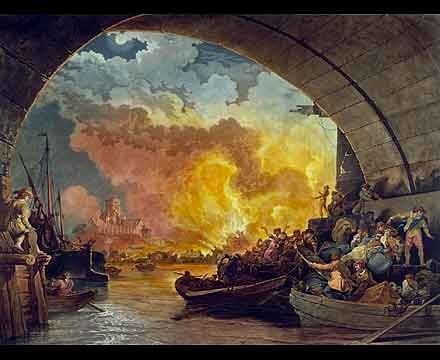
Day 4: Wednesday 5th September Day 5: Thursday 6th September
On the 5th two events conspired to save London: firefighters started to actively, use gunpowder to clear firebreaks on a wider scale. More crucially, the powerful east wind dropped. There was still a great struggle – Pepys reports than even the King was seen helping – but the tide had turned. Small fires still burnt by midday on Thursday 6th 1666, but they were soon under control.
The Aftermath
There was something of a witch hunt during and after the fire looking for the culprits and the London mob chased down any foreigners or just someone who looked a bit odd. A mentally ill Frenchman admitted to causing the fire and although it was shown that he could not have done so he was still hung. In the end calm prevailed and it was realised by those in government that it had just been an accident made worse by the condition of the city.
Rebuilding
The destruction was vast.
It is estimated that the destruction included 13200 houses, 87 churches, 44 Guild Halls, St Pauls Cathedral, Baynard's Castle, the Royal Exchange, Newgate prison and many other important sites. Maybe 1 person in 3 or 4 of greater London was made homeless. Something like £14 Billion of damages in today's terms was caused.
For some this was an opportunity. Unscrupulous bankers made a fortune giving loans at huge rate sof interest to assist rebuilding. Landlords discovered that they would insist on the properties they had rented out being rebuilt at the tenants cost and usually ended up with buildings of greater value. A massive legal process ensued with court cases going on for years.
Others had higher aims. John Evelyn and Christopher Wren both submitted plans for rebuilding the city. The warren of streets would be swept away and broad avenues and squares echoing the glories of Italian cities brought in. In the end though landlords insisted on their houses being rebuilt and the best that Wren achieved was the contract to design and rebuild London's churches including the magnificent St Paul's Cathedral.
This article is one of a series connected with the release in August of the new paperback of The Last Seal my historical fantasy set during the Great Fire of 1666. The book is also available on Kindle
August 24, 2011
A demon trapped under London in 1666
Character sketch from The Last Seal. Sketch is by Gill Pearce of Hellion's Art
Powerful and evil demon bound by the Praesidum who seeks release through the efforts of the Liberati.
More Info:
Ancient demon imprisoned three hundred years before by the sorceror Cornelius Silver in an ancient runic slab which was buried beneath Guild Hall and then protected from detection by a mystical shield emanating from six seals hidden round London. However, he can communicate via his Tome which was passed on through the Blake family and inherited by Artemas. Using this he instructs his lieutenant towards his goals.
Selfish, manipulative and powerful he is a potent foe for Ben.
Can Dantalion win his freedom?
To find out read The Last Seal.
Check out the book's Facebook page here:http://www.facebook.com/TheLastSeal
Read part of the book here: http://www.richarddenning.co.uk/thelastseal.html
August 23, 2011
Book Blog Tour Schedule for The Last Seal
Follow the Blog Tour for The Last Seal to find out.

To celebrate the launch of the new Paperback edition of The Last Seal I have organised a blog tour. From August 28th until early October there will be a series of Guest Posts, interviews and reviews on these sites.
You can follow the links for the tour below:
28th August
I am a Reader not a Writer
What to expect from The Last Seal
29th August
Murphy's Library
Book Review
30th August
Curling up by the Fire
Guest Post: A visit to London in 1666
Book Review
31st August
Above Average Below Special
Guest post: What was England like in 1666?
Book Review
1st September
The Slowest Bookworm
Guest Post – WHY did the Great Fire of London Happen?
Book Review
2nd September
The Book Bee
Guest Post: Blending History and Fantasy
Book Review
The First Day of the Great Fire
3rd September
Bookworm Confessions
Book Review
The Second Day of the Great Fire
4th September
Carole's Book Corner
Book Review
The Third Day of the Great Fire
5th September
Booksies Blog
Book Review
The Fourth Day of the Great Fire
6th September
My Love Affair with books
Guest Post: Reloading History – the appeal of Alternative Historical Fiction
The Fifth Day of the Great Fire
7th September
Moonlit Dreams
Book Review
8th September
Helen Hollick Muse and Views
Guest Post: How I used one fire to make a Game and two books
9th September
Knitpurlstitch
Interview: A day in the life of…
10th September
Lovely Old Tree
Guest Post: A guick tour round London in 1666
Book Review
12th September
Moonlight Books
Guest Post: A guide to the characters in The Last Seal
13th September
Library Thing
Book Review
14th September
Book Babblers
Book Review
15th September
Introduction to The Great Fire of London
16th September
Yeah Yeah Blogspot
Book Review
17th September
20th September
Sugar Peach
Book Review
22nd September
Sugar Peach
Interview
27th September
Knitpurlstitch
Book Review
28th September
Indie Book Blogger
Guest post on inventing a magic system for The Last Seal
August 21, 2011
Northern Britain 580 to 597 – The genesis of Northumbria
The Kingdom of Northumbria is born
by Richard Denning
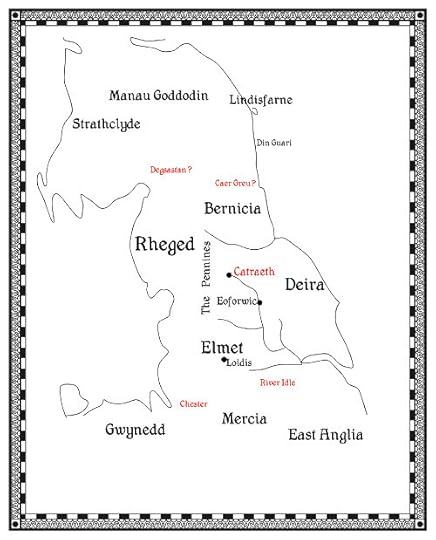
Northern Britain 580 to 616
The existence of the England we know today is strongly and rightly linked to the victories of Alfred the Great and his Kingdom of Wessex over the Vikings in the ninth century. Yet, three hundred years before Alfred's time, it was the creation of the powerful kingdom of Northumbria and its emergence as the dominant power in Britain for about a century, where we can see the roots of that England.
This was the Kingdom of Bede, the great chronicler of the late 7th. and early 8th. centuries and author of Historia Ecclesiastica Gentis Anglorum: 'The Ecclesiastical History of the English People'. It is also the land of the great kings, Aethelfrith, Edwin and Oswald, as well as the location of the Council of Whitby that established the form that the Christian Church in England would take: a form that lasted − more or less unchanged − until Henry VIII broke away from Rome some 900 years later.
One day, the Vikings would sweep it all away, but by then the mark left on the history of England by the golden age of Northumbria, could not be erased. How though does Northumbria come to exist? What are its roots?
A tale of two Kingdoms
In the 5th and early and mid 6th century two distinct groups of Angles migrate to Britain and settle in Northumbria. The first group to come were led by a figure called Soemil of which we know almost nothing. Sometime in the 5th century, possibly in response to appeals by the Romano-British inhabitants pleas for mercenaries, he establishes settlements along the river Humber and in the Yorkshire Wolds. These will one day become the kingdom of Deira in what is today Yorkshire.
In the 6th Century another Anglo-Saxon warlord, Ida and his family capture the fortress of Din Guardi – what is now Bamburgh and around this and settlements along the coast up to Lindisfarne they create a kingdom – Bernicia.
To begin with both are weak and small and surrounded by potent Romano British kingdoms of which the strongest was the Kingdom of Eboracii (what is now York) under King Peredur and further west Rheged under King Urien. Survival of the fledgling Anglo-Saxon enclaves may have been a lot to do with infighting between the various British kingdoms. Perhaps in the early stages the Angles avoided provoking the British too much but they were gradually expanding. The succession of kings in Bernicia is confusing and between circa 569 and 593 there seems to have been as many as 7 different Kings. It is likely that all of these (Ida, Clappa, Ada, Frithuwulf, Theowulf, Hussa, Aethelric) were all related and that Ida was succeeded by a series of sons, brothers or uncles most of whom may have died in battle.
After the mysteriousness Soemil the succession in Deira is totally unknown to historians BUT around 560 a strong king emerges – Aelle – who set about unifying the Deiran lands and establishing his own dynasty.
Slowly the invaders numbers grew, their lands expanded and finally the British took notice and began to take action.
Battle of Caer Greu
Around 580 King Peredur and his brother, alarmed by the growth of Bernicia, took an army north to attack them – probably in the time of King Ada. At a battlefield somewhere in Bernicia called Caer Greu the British army is defeated and the British Kings slain. Bernicia's immediate future is secured but this battle has a knock on effect as Aelle may well have taken advantage of the power vacuum at Eboracum (York) to capture the city. Certainly around the same time Eboracum becomes part of Deira. It was renamed Eorforwic. ( Which the Vikings would one day change to Jorvik and later people to York).
Crisis at Lindisfarne
The defeat at Caer Greu and the fall of York would have sent shock waves through the Northern British. The powerful king of Rheged, west of the Pennines in what is now Cumbria set about building an alliance of Kingdoms that included the kingdoms of Strathclyde, Gododdin (around Edinburgh) and others. He led an army on a furious campaign around the year AD 590 that swept across Bernicia and retook almost all the land lost to the northern Angles. The Bernicians under either Theodric or Aethelric (or maybe both as they were probably brothers. ) were besieged on the island of Lindisfarne and may well have been destroyed had the British alliance not then started to crumble and old rivalries emerge. Urien was assassinated by a fellow British ruler, Morcant before he could defeat the Angles and the heart seemed to have gone out of the British alliance. A resurgent Bernicia launched a counter attack that turned the tables on the losses suffered and in fact Theodric and Aethelric now invade Rheged.
Disaster in Rheged – Rise of Owain and Aethelfrith
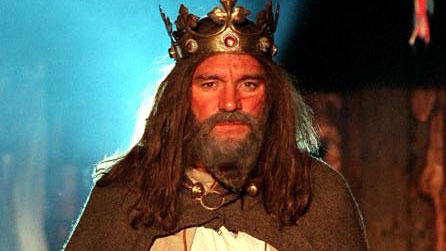
At some point in circa 590 to 593, whilst campaigning in Rheged, first Theodric and later Aethelric are killed by the son of Urien – Owain. Owain then seems to take a pause to regroup and rebuild the shattered alliances with his British neighbours. In Bernicia, meanwhile, this brings the powerful Warlord Aethelfrith, son of Aethelric to the throne. He too rebuilds his strength but it now can only be a matter of time before another huge clash ensued.
The Battle of Catreath – Owain tries to destroy Northumbria
That clash takes place at a place called Catreath in about AD 597. This is PROBABLY Catterick in Yorkshire which is located on the junction of two Roman roads – one over the Pennines to Rheged and the other the main north south road linking Deira and Bernicia. Strategically an army able to capture Catterick can turn on Bernicia OR Deira at will.
The battle of Catreath has passed into legend thanks to a Welsh Poem Y Goddodin that tells of the gathering of a host of British from various kingdoms and their march to Catreath. It tells of their bravery and prowess and the charge of the Goddodin cavalry. Then it tells of defeat. For whereever the battle occured Aethelfrith of Bernicia and probably Deira united to crush Owain and his alliance.
This defeat removed the risk that the fledgling Northumbrian Kingdoms would be easily destroyed. There were still enemies of course but Catreath can possibly be seen as the birthplace of Northumbria
In another article I will take the story forward as the Northumbrian Kingdoms once again unite to crush the Scots of Dal Riata at the battle of Degsastan and then turn on each other in a tale of exile and revenge that lasts 28 years.
The time period of this article is the same as my novel The Amber Treasure:
"I will take care of the body of my lord and you can carry the sword, story teller. For all good stories are about a sword."
6th Century Northumbria: Cerdic, the nephew of the great warrior Cynric, grows up dreaming of glory in battle and writing his name in the sagas.
When war comes for real though, his sister is kidnapped, his family betrayed and his uncle's legendary sword stolen. It falls to Cerdic to avenge his families' loss, rescue his sister and return home with the sword.
'Enjoyable novel set in sixth century Northumbria. Accurate detail and vivid fight scenes together with an engaging central character and his coming-of-age make this an absorbing read for fans of historical fiction…' The Book Bag
August 19, 2011
A decade a week: 1660 to 1665
The Return of the King
General Monck acts:
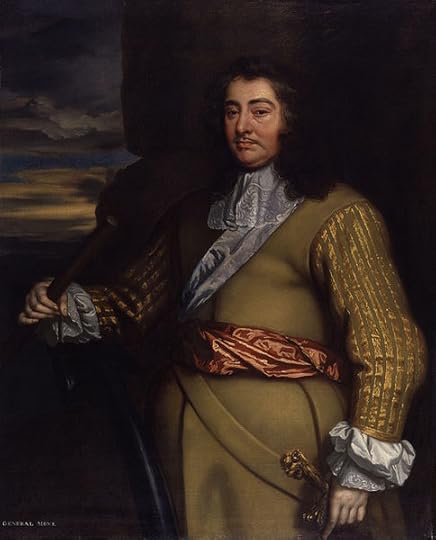
After Oliver Cromwell died in 1658 his son, Richard tried to govern as Lord Protector but he possessed none of the force of will of his father nor his support in the army and he was deposed. The Rump parliament tried to rule but itself was dismissed by one of Cromwell's officers, Lambert. Lambert tried to impose a military rule but his days in power were limited.
General Monck, Cromwell's trusted lieutenant in Scotland marched south in late 1659 with his army aiming to restore order and parliament. Lambert went out to meet him but his army deserted him and the Rump Parliament was restored.
Monck arrived in London in February 1660 and finding the Rump Parliament obstructive set about recalling the Long Parliament (the last full parliament originally summoned by Charles I many years before.) Lambert was sent to the Tower, escaped and tried to cause a republican uprising by summoning supporters to Edgehill but he was captured and this time did not escape. The Long Parliament, under Monck's guidance passed legislation designed to summon a Convention Parliament, whose role was to decide about the future of the nation, and then dissolved itself.
Monck, on behalf of the Convention Parliament began putting out feelers to Charles II, exploring the possibility of a restoration but seeking reassurances over reprisals. Charles, taking a pragmatic approach issued the Declaration of Breda in March 1660. This laid out conditions for his return which promised there would be NO reprisals against individuals for fighting against his father, nor against parliament with one exception. Anyone who had signed the execution order for Charles I was to be put to death themselves.
Party time in London: Charles returns!
The Convention parliament passed an act which stated that Charles II had been king since his father's execution in 1649 – in effect wiping the years of the Commonwealth away. Charles arrived in London on May 29th 1660 and entered the city under scenes of ecstatic excitement as if the country had been holding its breath during the dreary years of puritan goverment and now, all that drabness swept away, they let it all out in one huge celebration.
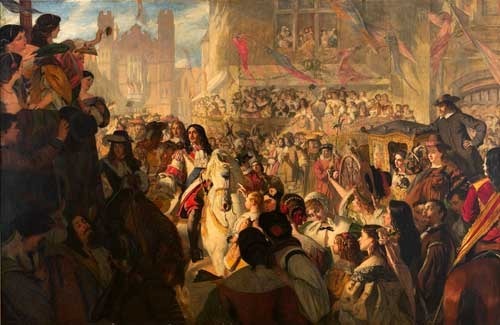
Regicides
Of the 59 judges who had signed Charles I's death warrant, 31 still lived. 8 of these along with three captains who had commanded the guards at the execution and the prosecuting lawyer were all executed at Tyburn by the grizzly method of hanging, drawing and quartering. Cromwell and two other senior republicans were exhumated and their corpses hung. Cromwell's head was then mounted on a spike on Westminster Hall.
Early Reign 1661 to 1664
In the early years, Charles appointed as chancellor Edward Hyde. At the same time, Anne Hyde, Hyde's daughter, revealed that she was pregnant by Charles's brother, James, whom she had secretly married. Edward Hyde, was created Earl of Clarendon and his position as Charles's favourite minister was strengthened.
Charles's coronation took place at Westminster Abbey on 23 April 1661. Shortly after the coronation, the 'Cavalier Parliament' was summoned and was, not surprisingly , it was overwhelmingly Royalist and Anglican.
The Cavalier Parliaments main aim was to discourage non-conformity to the Church of England, and so it passed several acts to secure this. Municipal office holders in the city were obliged to swear alliegance to the established church in The Corporation Act 1661. The Act of Uniformity 1662 made the use of the Anglican Book of Common Prayer compulsory. The Conventicle Act 1664 prohibited religious assemblies of more than five people, except under the auspices of the Church of England – in effect preventing ANY Catholic gatherings. The Five Mile Act 1665 prohibited clergymen from being inside five miles of a parish from which they had been banished. Much of these acts were known collectively as the Clarendon Code although Clarendon had little to do with them.
The Restoration lead to many changes in society. Puritanism – so dominant in the Commonwealth and the 40′s lost its momentum. Theatres were once again opened and bawdy "Restoration comedy" became popular.
Alliance with Portugal 1661 and War with Holland starts again 1665
Soon after Charles's restoration, Queen Luísa of Portugal, agreed an alliance with England which lead in May 1662 to Charles marrying Catherine of Braganza in Portsmouth. Under the alliance the territories of Tangier and Bombay were transferred to British control which would in the case of Bombay have a large effect on the development of the British Empire in India.
Charles also sold Dunkirk – England's last enclave in France because it was too costly to maintain.
The Second Dutch War was started as a result of England trying to take control of Dutch colonies. The first year or two of the war went well for the English, with the capture of New Amsterdam (renamed New York ) and a victory at the Battle of Lowestoft.
The Great Plague 1665
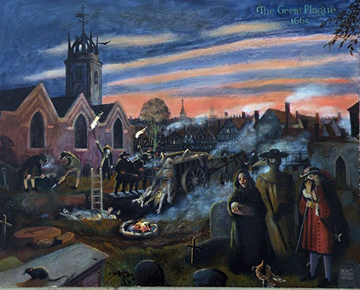
London – and indeed all of Europe were familiar with intermittent plagues throughout history with the 14th Century Black Death killing for around 1 in 3 in England. Plagues in the 17th century were not as dramatic as that but the Great Plague of 1665 would kill 100,000 Londoners (and thousands more around the country) and was the last large scale plague in England.
In April 1665 the first case of bubonic plague occurred - thought to be carried in Dutch ships (before the war started). Soon it began to spread with numbers increasing rapidly. By September 1665 7000 people a week were dying and the city was digging great pits to bury the dead in. Those that were able to fled – the Kind going to Salisbury and later Oxford where Parliament also removed itself to. Finally as Autumn turned to winter the death rate slowed and the King and parliament felt safe to return to London early in 1666. Although on a much smaller scale the plague was still going on in the summer of 1666 when something dramatic and terrifying occurred - something which would wipe out the plague once and for all but at a terrible cost.
Next week: By Permission of Heaven – the Great Fire of London
Coming next week: The year 1666
This article is one of a series connected with the release in August of the new paperback of The Last Seal my historical fantasy set during the Great Fire of 1666. The book is also available on Kindle
August 17, 2011
King's Spymaster on the trail of foreign agents and conspirators
Character sketch from The Last Seal. Sketch is by Gill Pearce of Hellion's Art
Brief Note: King's Spymaster who suspects Ben and friends are foreign agents and conspirators.
More Info: Ruthless and cynical, Gymer is King Charles' Spymaster whose primary concern is the safety of the 'King and his Kingdom'. To individuals that he believes threaten the Kingdom, he proves to be cold-hearted and merciless. When a tip off from the Liberati brings Gymer to Tobias' door, he begins a campaign to prove Tobias is a Dutch agent. Gymer's pursuit of Ben and his friends but in particular Tobias is a thread running through the book.
In the end will Gymer discover the true threat to ' The King and his Kingdom' is the demon Dantalion?
To find out read The Last Seal.
Check out the book's Facebook page here:http://www.facebook.com/TheLastSeal
Read part of the book here: http://www.richarddenning.co.uk/thelastseal.html
August 16, 2011
Libraries that have left their mark.
Libraries that have left their mark.
by Richard Denning
The magic and wonder of libraries
Originally published on the Asasmum Blog.
Early this year I was kindly invited to do a guest post on a Blog called Asasmum which no longer exists. The subject that was suggested was libraries and what impact they have had on me. At first I thought – heck what on earth do I write about. But then you start thinking and before long a great many popped into mind. Some of these are real, some have not existed for a long time and some mythical or fictional but all have had a profound impact on me.
You see, I love books. I always have done since I begged to be taught how to read at the age of about four. My parents were keen readers too and although we did not have a particularly large book collection at home we were frequent users of libraries and so new books of all types would turn up every few weeks. My uncle had a bedroom where I would stay on visits to him when about eight years old. This was a spare room and was piled high with books of all types. The first time I saw and read The Lord of the Rings was in that room. I loved visits there and would stay up late at night reading books which I had never come across before.
As a teenager I loved dropping into the local library in Warwick. This was at first in an old building next to St Mary's Church where many an Earl of Warwick was buried. Later it moved to a less atmospheric but larger modern building. I would spend hours reading there and borrowing mystery stories, history, fantasy and sci fi.
University Libraries
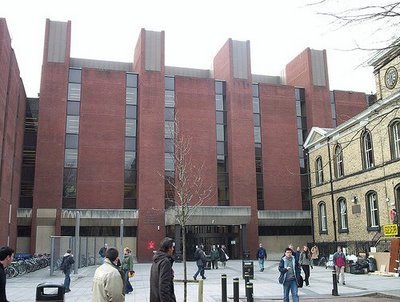
I was a medical student at Manchester University. The main John Ryland's Library was hardly an attractive building but it did seem vast to me when I went there in 1985 and, like the University library in Birmingham where my wife later did a Phd, it contains huge stacks of books. It is the sort of place you can get lost in and impresses with the vast number of volumes it contains. You almost feel like you are learning something just by walking along.
Impressive as the Manchester University main library was there is another smaller but much older library in Manchester that has been called on the 12 most beautiful in the world. It is Chethams Library and dates back to 1653. It houses thousands of early printed books, manuscripts, diaries and genealogical records. It is possible to visit and if you are researching your family history you may even find it worthwhile. For atmosphere and beauty it is well worth a look.
Other old libraries
It is currently not possible to access the Old Reading Room of the British Library as building work is going on in the British Museum, BUT I hope they reopen it soon because for me this huge circular room is almost a Wonder of the World. Around the outside is a collection of works by the vast number of famous authors who at one time laboured there. It is now really just an index to the main collection which has moved elsewhere and in the modern age almost irrelevant as you can look up most of the books online. But what a wonderful place to visit.
If you are ever in Oxford and enjoy libraries, book yourself into to a tour of the Old Bodleian Library. The history you will learn is fascinating enough but for me the high point of the visit is seeing the massive leather bound volumes that are literary chained to the shelves so valuable are they.
Mythical and Fictional Libraries
Books chained to shelves brings me on neatly to libraries that I would love to visit were I able to.
The Library of the Unseen University
This is the library in the magical university in Terry Prachett's wonderful Diskworld. The library has so many powerful books in it that they exert a magical effect on the surroundings and warp space. So, like the Tardis, the library is bigger on the inside than the outside. It is supposed to go on forever and have openings into other dimensions. It's a dangerous place but sounds really fascinating.
Hogwarts School of Witchcraft and Wizardry
The library here is perhaps a bit tamer than the Unseen University BUT the way it is depicted in the books and movies always drew me in. I loved the face jumping out of one volume in the first book as well as the idea of "restricted" sections and spells for everything being there somewhere.
The Great Library of Alexandria
This library was destroyed during Julia Caesar's time in Egypt but was considered to have housed the greatest collections of scrolls from ancient times. When it burnt to the ground it took with it some of the finest works of the best thinkers and philosophers the world had known. A true disaster indeed. Possibly one of the ideas which got me thinking about a time travel novel was pondering that it would be nice to be able to go back and visit it. Maybe rescue some of the scrolls.
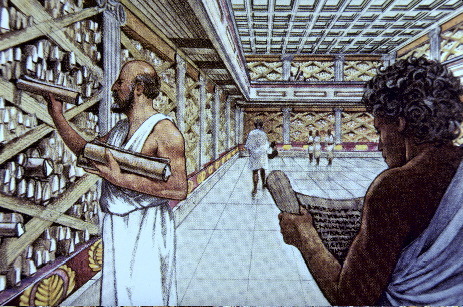
The Library of the Hourglass Institute
It is hardly a surprise given how libraries have had such an effect on me that I made something of the collection in the Hourglass Institute in my novel Tomorrow's Guardian:
Fuming, he stomped off down the hallway. He almost opened the dining room door, but then he heard Charlie laugh and Mary giggle and feeling that he could not face them all right now, he went through to the library and drifted about the room, scanning the spines of books vaguely, while he tried to think.
The Professor had a large collection of books on more or less every subject, yet here, just like in his office, the emphasis was on history, maps and politics. It appeared the Institute needed its Walkers to have access to as much accurate information as possible on all the times and places they might have to visit. Idly, Tom wondered what happened if history was changed. Would the contents of the books change? He supposed they must do; unless a Walker was carrying the book back in time whilst the effect of changing time occurred. That is what had happened to Tom, of course. What had Septimus called him? An anomaly, a paradox? Something that could not exist and yet did …
The Magic of Libraries
It is striking how often Libraries figure in fiction and in particular fantasy novels. Then again it is hardly surprising because all libraries, just like all books, are in some way a little bit magical. The older the building and the older the books the more the effect, but to me there is a sense of wonder, a feeling of peace and a vast sensation of potential for knowledge and adventure that these places have. As such It has been fun to conduct this little tour down memory lane and I hope you enjoyed the trip.
Richard Denning
Tomorrow's Guardian Paperback Published: January 2011
ISBN: 9780956483560 (Hourglass Institute Series Book 1) Published by Mercia Books.
August 13, 2011
3 tools for making the most of Twitter
Twitter (like facebook) and other social networks are not only a good way to keep in touch with friends, find out about news, collect tips and links to helpful blog articles but is also, for an author, an indispensable way of spreading the word about your own books. Yet it can soak up a lot of time. In this article I look at some tools to help you make the most from Twitter.
Making the most of twitter
To get the most out of twitter you need to put effort into:
Expanding your network of followers. If you don't have many followers you won't have many people listening to what you have to say. If you only have say 20 followers than each time you tweet you can only reach 20 people. They might retweet your comments BUT the more followers the more likely this will be.
Getting followers who are interested in WHAT you have to say. This means linking up with people who have the same interests as you. If you tweet, as I do, about history, sci fi and writing then you want followers who find that interesting. Ever been to a party and said "did you see DR Who (insert program you watch here) last night?" only to be met with stony silence. How much did you enjoy that party? What about the contrast with a party when you said that and five people responded and a debate on who played the best Doctor ensued!
Following people who share the same interests. This is all the same thing thing as 2 above really. If you follow someone they may follow you back and you might start up a bit of a relationship. I learn a lot be reading blogs and tweets of OTHER writers and folks interested in history. Twitter should be a two way thing. If you are just talking and not listening you wont get as much out of it.
Unfollowing people occasionally. What? Why do that? Well there are several reasons. Firstly Twitter will restrict the number of people you can follow to only 1.2 x the numbers of followers you have when you reach 2000 followers. Not an issue for me yet (I have 900 and something) but if you are following someone who is NOT following you they are potentially restricting your growth. If you are following someone who if not following you then you don't that 2 way relationship going on anyway and so you are not getting that much out of them. You may also find you are following someone who just fills your timeline with adverts or tweets like "win an Ipad" all the time. Competitions are fine BUT if they are 90% of that user's tweets you don't get much out of following them do you?
Responding to people when they mention you, retweet you etc. This is not just polite but helps to build that relationship.
Only so many hours in the day
But this is the issue. All this activity takes time. being active on social media is an important part of marketing books these days but it is easy to lose hours in it. If you have a day job too, are working on a book etc – well it all cuts in to available time. THAT is where tools come in which can help this process. I am going to mention 3 which I have used.
1. Tweetdeck
 Tweetdeck is a great piece of free to download software. You can setup an account on it and link in multiple twitter accounts as well as Facebook. Then you can set it up so that it has a different column for each Twitter account time line, your mentions feed, direct messages feed etc. See above I have my main twitter account @richarddenning as well as my @merciabooks one, a column for mentions of @richarddenning and one for any messages. Off screen to teh right (and scrollable) i have other columns set up for some regular searches, scheduled tweet etc.
Tweetdeck is a great piece of free to download software. You can setup an account on it and link in multiple twitter accounts as well as Facebook. Then you can set it up so that it has a different column for each Twitter account time line, your mentions feed, direct messages feed etc. See above I have my main twitter account @richarddenning as well as my @merciabooks one, a column for mentions of @richarddenning and one for any messages. Off screen to teh right (and scrollable) i have other columns set up for some regular searches, scheduled tweet etc.
All of this means you can keep a check on all that is going on and respond more quickly. Tweetdeck also allows for scheduling of tweets – useful for when you are away and want to keep up some activity online. Because tweetdeck saves the profile online you can install it on a home pc and a laptop, access the same information and keep more in touch.
2. TweetAdder
TweetAdder is a pay for use service but it is not too expensive at $55 for one twitter account and discounts for buying for multiple accounts. Once you have paid there is no ongoing charge. What you do is set up you account and then use TweetAdder to help you find followers. How do you do this. Well TweetAdder can search for folk who share a common interest with you. It does this by searching Twitter profiles, posts etc You can ask it to save the findings of that search to a list of people to then follow. Hopefully you are linking to people who are interested in the same things you are. You can also get TweetAdder to send a little welcome message to anyone who follows you. It can also un-follow people who have not followed you in a specified time period to keep you follow and followers list dynamic.
Once setup you can let it roll and concentrate on the blogs and writing and interacting with people.
3. Klout
How do you know how well you are doing connecting with people? How can you gauge the success of you activities online? Well this is where Klout comes in. You setup an account and link Klout to your Facebook and twitter account and several other online accounts. Klout then analyses things like how many followers you have, how many retweets you get etc. All that boils together into a score that shows how much splash you are making online. Klout presents its findings in a series of graphs and also places you in a category of online user. I am Explorer at present – finding my way but quite active. What I found interesting was during a recent 16 day holiday when my online access was poor my score fell from about 47 to about 40 which shows that you need to maintain activity at a fairly frequent level to make the most of twitter.
Being active on Twitter can take up a lot of your time – time that perhaps you would rather be writing in. These tools help by giving you some of that time back.
August 12, 2011
A decade a week 1650 to 1659
The King is dead. Long live the Republic!
Depending on how you interpretative matters the Kingdom of England came into existence sometime between 886 when Alfred the Great ruled all parts NOT controlled by the Vikings and 927 when Aethelstan conquered the Viking lands and formally united all of England under one King. Taking the later date, then, one can say that there has been a Kingdom of England for 1084 years. In all that time the nation has spent just 11 as a republic. This was the time of the Commonwealth of England (later of England, Scotland and Ireland).
In 1649 Charles I was tried and found guilty of High Treason and executed. But he did not die under the name King Charles. His death warrant stated that a certain Charles Stuart was to die, for the Rump Parliament had already started passing laws that formulated a republic.
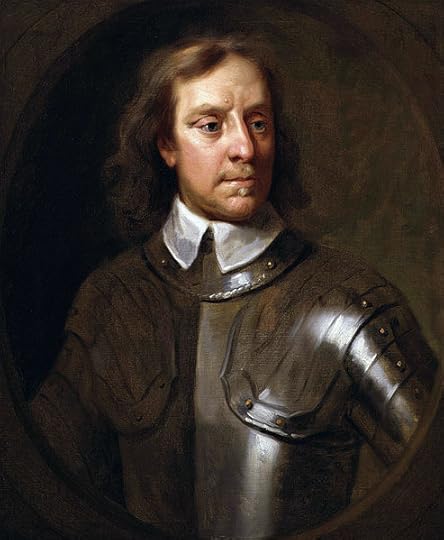
The Rump Parliament – Christmas is banned!
The army – which by this point was answerable to Oliver Cromwell – had ejected most of the members of the Long Parliament which Charles had originally summoned. The only members allowed to stay on where republicans and puritans whom the army could rely on to first put Charles on trial and then rule the way THEY wanted.
The first acts of the Rump were to take steps to transform England into a republic. The House of Lords was abolished along with the Privy council and now a council of State governed. The Rump then passed laws doing away with bishops and enforcing attendance of church on Sundays. A law had already been passed by the Long Parliament banning the celebration of Christmas and this was enforced under the Commonwealth. Soldiers were ordered to seize food being cooked for Christmas. Traditional Christmas decorations like holly were banned. Women were also forbidden to use make up at this time.
In all these changes Parliament did not take steps to determine who could call and dissolve parliament. Constitutionally this was – and still is – the role of the monarch. This failure would soon cause problems.
Wars in Ireland (1649 to 52) and in Scotland (1650 to 1651)
Cromwell once said "I had rather be overthrown by a Cavalierish interest than a Scotch interest; I had rather be overthrown by a Scotch interest than an Irish interest and I think of all this is the most dangerous"
In the years 1649 to 1651 he had to deal with all three – Ireland, Scotland and Royalists.
Firstly came Ireland.
Cromwell saw the Irish rebellion as a huge danger and in particular was bias against Roman Catholicism which he saw as raising human authority – that of bishops and popes – above that of the bible and of God. Intervention there actually started in 1649. By this point The Irish Catholics and the Protestant Royalists had forged an alliance against the Parliamentary forces who were restricted to small enclaves including Dublin. Cromwell took an army there in August 1649. What followed was a bloody campaign of suppression of his enemies. There were several massacres including the notorious sieges of Droghedra and Wexford where over 3000 people were killed in each case including many civilians. Gradually the country was brought under his authority. When he left in May 1650 it would still be 2 years before a Settlement of Ireland ended the war. In this settlement the Catholics lost almost all land. Priests and Catholic churches were also banned. It was the darkest of time for the Catholic majority who were firmly under the boot of Cromwell's Commonwealth.
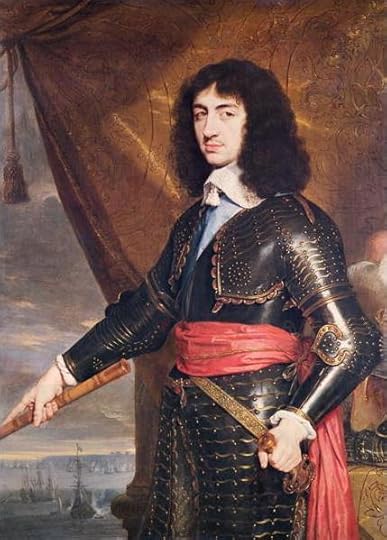
Charles II
Next: Scotland and the Royalists – Charles' son tried to retake the throne.
Charles' I son – also called Charles (the future Charles II) made an attempt to seize his throne in 1650 and 51 . Landing in Scotland in June 1650 he started gathering an army of Scottish Presbyterian Covenanters and Royalists.
Cromwell having returned from Ireland was soon back on the road and joined General Monck – the Parliamentarian commander and an important figure in the Restoration of the monarchy in 1660. Cromwell appealed to the Covenanter forces to abandon Charles. When they refused he smashed their army at the Battle of Dunbar.
Winter 1650 passed with Charles and Cromwell's armies wintering in Scotland. In 1651 the war continued. Whilst Cromwell steadily brought more of the country under Parliament's rule, Charles decided to try his luck else where and in the summer of 1651 he advanced into England gathering a following along the way. However the response was poor and he was only able to gain 14,000 men to his colours. Leaving Monck in charge in Scotland, Cromwell was able to pursue and catch up with Charles at Worcester with 32,000 men. In the battle of the 3rd September the Royalist Army was destroyed. 3000 were dead and many thousands more deported or drafted into the New Model Army for service in Ireland.
Prince Charles evaded capture and at one time even had to hide in a now famous oak Tree at Boscobel House (you can see the grandson of this famous tree in the same spot today) before fleeing overseas. His gamble had failed and it would be 9 long years before he was able to return as king.
First Anglo Dutch War
At this time Holland was a powerful trade nation. Under the excuse of hampering Royalist effort, English ships began to board Dutch ships searching for Royalists. This antagonised the Dutch and relations deteriorated. Between 1652 and 1654 the two nations fought a series of large sea battles as well as seizing each others ships. The motivation was all about trade rivalry. Cromwell eventually negotiated peace but there would be war again in the next decade.
1653 – Cromwell dismisses Parliament
The Rump governed England from 1649 to 1653 when Cromwell decided to dissolve it. It may be that the Rump had suggested elections. This would possibly mean new MPs being admitted, some of which might be opposed to the republic. For whatever reason Cromwell, marched into parliament with an armed guard and evicted the members. This was seen as illegal under the same rules that Parliament had brought in to prevent Charles I dissolving them.
Barebone's Parliament 1653
Cromwell now had a problem. He had no parliament but neither was their any clear mandate to summon parliament, call an election etc. Such actions were Royal Prerogatives which as yet had not been reorganised. So since there was no King no one call call Parliament.
Not wishing to become a dictator, Cromwell decided that the temporary solution was to rule through a 'nominated assembly.' Army officers were asked to suggest members of parliament. The problem was that the assembly ended up being made up of a mix of radicals who wanted to be rid "earthly government" and any state control of religion, moderates who wanted to reform the existing system and Conservatives who wanted to keep the status quo. Cromwell wanted this assembly to legislate a constitutional framework for government but they proved unable to do this.
In December 1653 Cromwell dismissed the assembly and elected to set up a protectorship.
The Protectorate established: 1653
An Instrument of Government was written which created the role of Lord Protector. Cromwell was sworn into a post which carried with it most of the rights of Kings – although there was provision for votes by parliament to approve his actions.
Cromwell set about trying to heal the nation after all these years of war and strife. He also wished to bring in moral and spiritual reforms. Unfortunately, the First Protectorate Parliament that he called did not help with these altruistic goals, as they turned out to be full of radical republicans who wished to push through even more extreme republican measures. He dissolved it in 1655.
Rule by Major Generals
In 1655 there was yet another Royalist uprising – this time in Cornwall. It did not last long and after it Cromwell decided to turn to his true power base – the Army. He brought in direct military rule by a system of 15 Major Generals who governed their pats of the country and would enforce his decrees and also raise taxes. This strict military rule proved deeply unpopular and was abandoned in 1656.
1657 – The Protector becomes even more like a king
It is a great irony that the one man who more than any other brought about the execution of a King and the dissolution of the monarchy was the same who in effect finally took on the trapping of kingship. In 1657 Parliament re-endorsed the Protector-ship in what amounted to a coronation ceremony. Yes it is true that Cromwell declined the title of King but he wore an ermine cloak and sat in Edward the First's chair in which all monarchs of England have been crowned in. In the end he even brought back a second house of Peers (in effect of Lords) and started creating barons.
Cromwell dies
In 1658 Cromwell died. He was buried in great ceremony – in effect a Royal Funeral. His son – Richard – inherited the role of Lord Protector but he did not have the same political backing and in particular lacked the support of the Army. Richard Cromwell was deposed by an officers' coup in April, 1659. The officers then re-summoned the Rump Parliament to sit. The Rump clashed with the army and in the end the Rump was forcibly dismissed by Parliment under the command of Lambert – one of Cromwell's officers.
It now seemed that a period of military rule would ensue. Fearing anarchy and motivated by the need for stable government General Monck – Cromwell's Viceroy in Scotland began the march south. Upon that march would depend the future of England. I will cover what happened in the next of these blogs.
Next week: the Return of the King
One could argue – and it certainly seemed the case that in the mid 17th century England needed rule by a head of state. Parliament it proved to be the case can only do so much. A single man or woman has to be imbued with the power of head of state – of monarch in effect. Someone has to be in charge. Later experiences with republics would do this by creating Presidents. England's experiment ended by bringing back Kings and Queens. Next week I will cover how that happened in 1660.
Coming next week: 1660 to 1665
This article is one of a series connected with the release in August of the new paperback of The Last Seal my historical fantasy set during the Great Fire of 1666. The book is also available on Kindle

